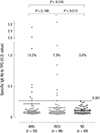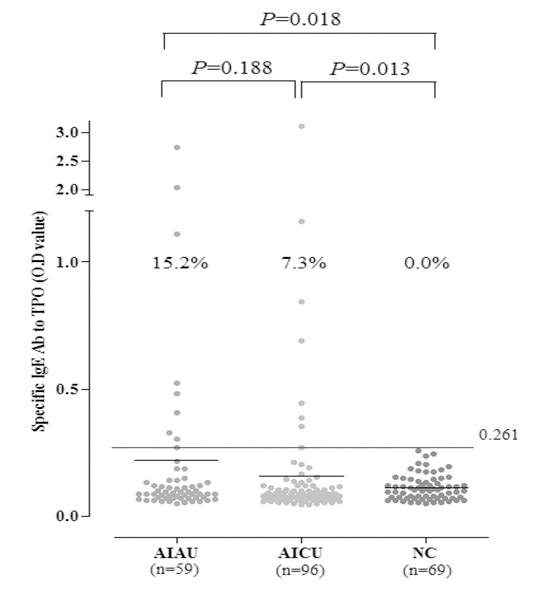Abstract
Figures and Tables
 | Fig. 1The prevalence of serum specific IgE to TPO. Serum specific IgE to TPO was measured by manual direct ELISA system from AIAU (n = 59), AICU (n = 96), and NC (n = 69) groups. The cut-off value for serum specific IgE to TPO level was defined as mean and three standard deviation of healthy controls. AIAU, aspirin intolerant acute urticaria; AICU, aspirin intolerant chronic urticaria; NC, normal control; TPO, thyroid peroxidase. |
 | Fig. 2Expression level of CD203c on basophils. Peripheral blood basophils were obtained from two subjects with high serum specific IgE to TPO and healthy control. The expression of CD203c on basophil were measured with the additions of TPO to prove a direct role of specific IgE to TPO on effector cells of urticaria. AIAU, aspirin intolerant acute urticaria; AICU, aspirin intolerant chronic urticaria; NC, normal control; TPO, thyroid peroxidase. |
Table 1
Clinical and laboratory characteristics of the study subjects

P values were calculated using t-test. *Data are expressed as mean±standard deviation; †Data are expressed as number of positive patients with percentage given in parentheses. P values were calculated using Pearson's chi-squre test. Total IgE>114 IU/mL was regarded to elevated level, ECP>13.5 µg/L was regarded to elevated level, the cut-off value for serum specific IgE to TPO level was defined as mean and three times standard deviation of absorbance values from 69 healthy controls. AIAU, aspirin intolerant acute urticaria; AICU, aspirin intolerant chronic urticaria; NC, normal control; UAS, urticarial activity score; ECP, eosinophilic cationic protein; ND, not done; NA, not applicable.
Table 2
Characteristics of study population according to the presence of serum specific IgE to TPO in aspirin induced urticaria.

P values were calculated using t-test. *Data are expressed as mean±standard deviation; †Data are expressed as number of positive patients with percentage given in parentheses. P values were calculated using Pearson's chi-squre test. AIAU, aspirin intolerant acute urticaria; AICU, aspirin intolerant chronic urticaria; NC, normal control; UAS, urticarial activity score; ECP, eosinophilic cationic protein; ND, not done; NA, not applicable.




 PDF
PDF ePub
ePub Citation
Citation Print
Print




 XML Download
XML Download